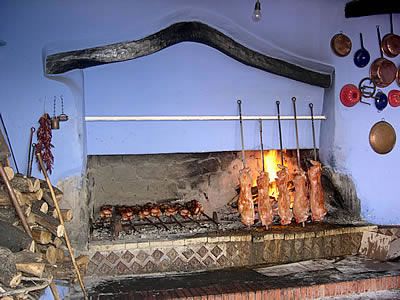Sardinian cuisine
Sardinian cuisine is a celebration of natural products from the land and surrounding sea. It unites dishes from the ancient pastoral and farming traditions with those based on fish and seafood, and the flavours of the natural ingredients are exalted by the unmistakable aromas of the island’s Mediterranean essences. Even today Sardinian cuisine is strictly linked to the seasons and its secret lies in the quality of the ingredients and the simplicity of its dishes. It offers visitors a triumph of unique flavours, with each area boasting a vast selection of local specialities, all prepared according to ancient traditions and customs.
Aromatic wood
The fine products provided by both the land and sea mean that the choice of delicious main courses is particularly rich. Among the many celebrated meat dishes, the most well-known is unquestionably “porceddu”, suckling pig cooked on a spit or “a carraxiu”, that is to say cooked in a hole dug in the ground, using the aromatic wood of the Mediterranean scrub land. However, there are numerous other mouth-watering dishes, such as rabbit “a succhittu”, served in a sauce made from the rabbit’s liver, wine, capers and tomatoes; wild boar in Cannonau wine; stewed thrushes and quail wrapped in myrtle leaves. The choice of fish dishes is endless. Lobster is prepared with citrus fruit in Alghero, with tomatoes in Bosa, grilled in Sant’Antioco and with white wine in Santa Teresa di Gallura. Whilst in Cagliari, at Poetto beach visitors can sample sea urchin eggs spread on toasted bread, as well as “burrida”, dogfish with walnuts and vinegar. In and around Oristano the traditional dish is “merca”, mullet steeped in salt water with herbs. While bottarga (salted or dried mullet or tuna eggs) is a favourite all along the south west coast of the island and is considered Sardinia’s caviar. Sardinia also excels in some products which are becoming well-known and appreciated even outside the island’s boundaries. Among the most celebrated exports are the wines (cannonau from the Campidano region, Vermentino from Gallura), the cheeses (pecorino romano, fiore sardo) and extra virgin olive oil. However, Sardinian cuisine is also strictly linked to the production of wheat (imported by the Romans, who called the island the granary of Rome) and flour, traditions which are revealed in the rich selection of local bread, pasta and desserts.
Sardinian pasta
In fact, the different types of dried pasta we see today almost certainly originated from the traditional Sardinian pasta, which was left to dry in the open air and in the sun. The best examples of these are: “fregula”, which in Cagliari is served with clams and is a bran pasta prepared in small balls; “culurgiones”, ravioli with a variety of fillings (ricotta, saffron, mint, meat and prawns); “malloreddus”, typically served with a sausage and tomato sauce. However, it is perhaps the production and elaboration of bread which best illustrates the quality of Sardinian flour and the island’s age-old tradition. Each region boasts its own speciality bread, made with special techniques and according to ancient recipes. Sanluri is famous for “civraxiu”, Ozieri for “spianata”, Ogliastra for “pistoccu”.
Nevertheless, a special mention must be dedicated to “pane carasau”, wafer-thin sheets of toasted bread also known as “carta da musica” (music paper). This bread is typical of the Barbagia region and was a staple part of the shepherds’ diet, together with “pane frattau”, a sort of pie made from “pane carasau” baked with tomato sauce, pecorino cheese and boiled eggs. Finally the desserts. “Sebadas” are round, sweet ravioli, filled with cheese, which are fried and then cover in honey. The speciality biscuits of Ozieri are the “sospiri”, while Tonara is famous for Sardinian nougat. The Campidano region offers delicious “gueffus” and “candelau”, the Barbagia has its “piricchittus” and “pabassinas”, while throughout the island visitors can taste numerous biscuits made from almonds and sweet cheeses.

 English (UK)
English (UK)  Italiano
Italiano 


